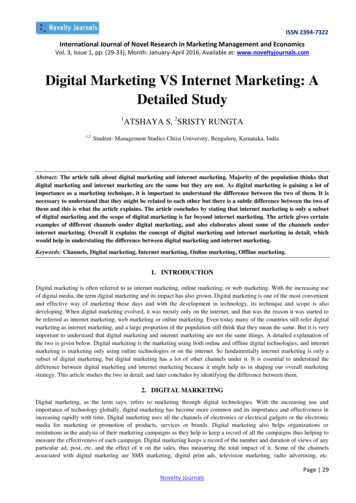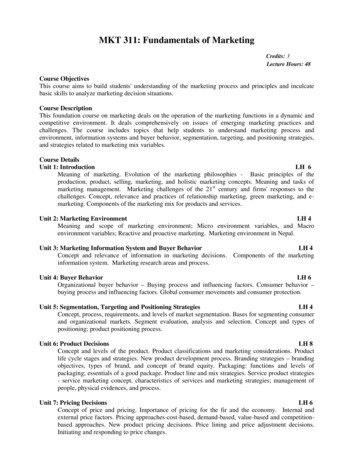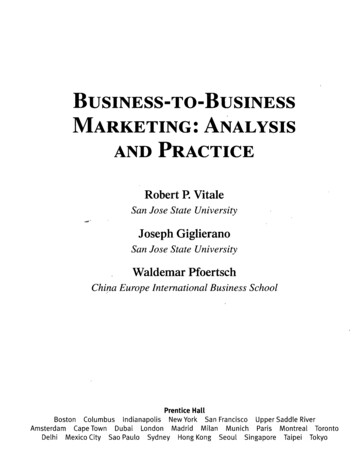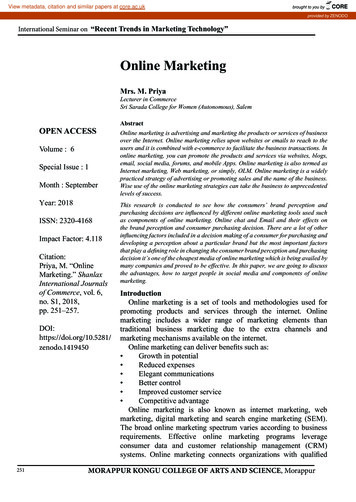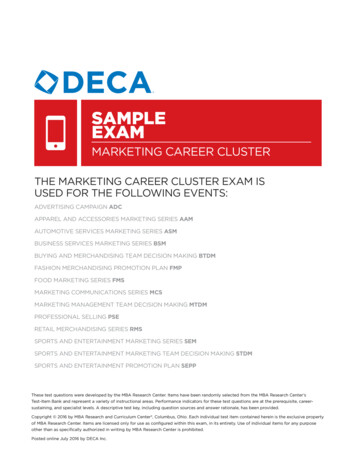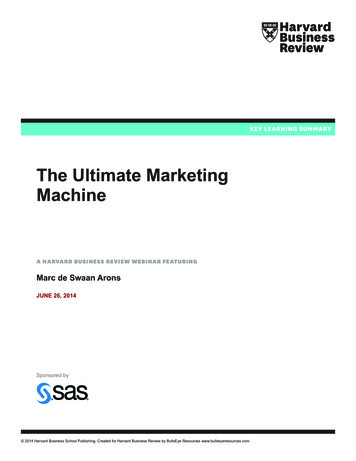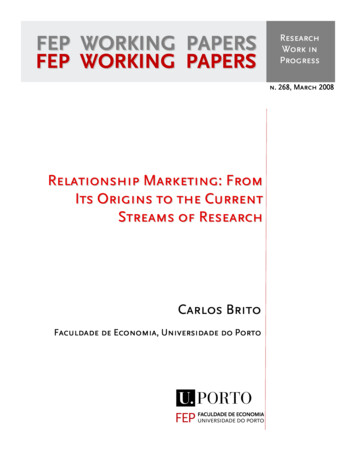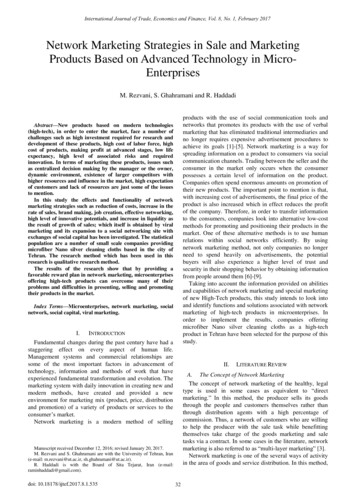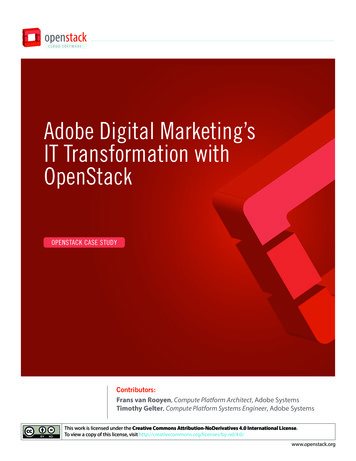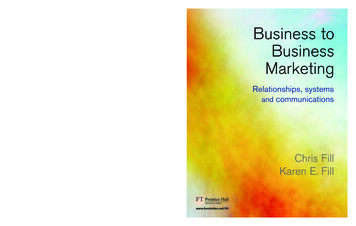
Transcription
"Business-to-Business Marketing will help change the view students may have ofB2B as a less glamorous, creative or interesting area of marketing. Excellentlywritten, well presented and full of real life illustrations, Business-to-BusinessMarketing is a pleasure to read and I will gladly recommend it to my colleagues."Adriana Dredge, Senior Lecturer at LCP, London InstituteA superb examination of the integration of relationships and technology that characterisecontemporary B2B marketing practice! Chris and Karen Fill bring to life B2B marketing from amarketing management perspective. Unlike other books in this area, Business-to-BusinessMarketing: relationships, systems and communications considers the subject through twoprimary themes — the management of interorganisational relationships AND the impact ofinformation systems and technology on organisational performance.“Business-to-Business Marketing is comprehensive and rigorous, yet highlyaccessible. The material is bang up to date, with a plethora of examples fromaround the globe and a bold assertion of the importance of IT and the Internet.I really enjoyed reading this new book and I am sure my students would be similarlyenthusiastic.”Nick Ellis, Research Fellow in Marketing, The Management Centre, University of LeicesterGeared toward both postgraduate and final-year undergraduate students, this book is idealfor those studying Marketing, Marketing with eCommerce, Media and Multimedia Marketing,Business Studies, eBusiness and Business Information Systems, and for MBAs. It can also be usedfor related units in Engineering- and Social Studies-based programmes. Students following theCIM’s Professional Diploma Module, Marketing Communications, will also benefit from thisbook, as well as those taking stand-alone professional B2B Marketing seminars.Karen Fill has worked in the commercial world as a systems analyst/consultant. She is currentlyworking at the University of Southampton as a researcher in the field of educationaltechnology and learning Business toBusinessMarketingRelationships, systemsand communicationsChris FillKaren E. FillChris FillKaren E. FillChris Fill is currently Principle Lecturer in Marketing and Strategic Management at theUniversity of Portsmouth. Recently appointed a Fellow of the Chartered Institute of Marketing,he is also their Senior Examiner for the Marketing Communications module.Business to Business MarketingRelationships, systems and communicationsRelationships, systems and communicationsBusiness to Business Marketingwww.booksites.net/fill
Business-to-Business Marketing
We work with leading authors to develop thestrongest educational materials in business and marketing,bringing cutting-edge thinking and bestlearning practice to a global market.Under a range of well-known imprints, includingFinancial Times Prentice Hall, we craft high qualityprint and electronic publications which help readersto understand and apply their content, whetherstudying or at work.To find out more about the complete range of ourpublishing, please visit us on the World Wide Web at:www.pearsoned.co.uk
Business-to-BusinessMarketingRelationships, Systems andCommunicationsChris FillUniversity of PortsmouthKaren E. FillUniversity of Southampton
Pearson Education LimitedEdinburgh GateHarlowEssex CM20 2JEEnglandand Associated Companies throughout the worldVisit us on the World Wide Web at:www.pearsoned.co.uk Pearson Education Limited 2005The rights of Chris Fill and Karen Fill to be identified as authors ofthis work have been asserted by them in accordance with the Copyright,Designs and Patents Act 1988.All rights reserved. No part of this publication may be reproduced, stored in a retrievalsystem, or transmitted in any form or by any means, electronic, mechanical,photocopying, recording or otherwise, without either the prior written permission of thepublisher or a licence permitting restricted copying in the United Kingdom issued by theCopyright Licensing Agency Ltd, 90 Tottenham Court Road, London W1T 4LP.All trademarks used herein are the property of their respective owners. The use of anytrademark in this text does not vest in the author or publisher any trademark ownershiprights in such trademarks, nor does the use of such trademarks imply any affiliationwith or endorsement of this book by such owners.ISBN 0 273 68279 2British Library Cataloguing-in-Publication DataA catalogue record for this book is available from the British LibraryLibrary of Congress cataloging-in-Publication DataA catalog record for this book is available from the Library of Congress10099 8 7 6 5 4 3 2 108 07 06 05Typeset in 9/12pt Stone Serif by 35Printed and bound by Ashford Colour Press Ltd, GosportThe publisher’s policy is to use paper manufactured from sustainable forests.
ContentsPREFACEACKNOWLEDGEMENTSxixviiPart A Introduction1132AN INTRODUCTION TO BUSINESS-TO-BUSINESS MARKETINGChapter overviewChapter aimsObjectivesIntroductionThe characteristics of business marketsTypes of organisational customersTypes of business goods and servicesThe characteristics of B2B marketingB2B marketing management approachesUnderstanding value and supply chainsThe importance of B2B relationshipsSummaryDiscussion ION TO BUSINESS INFORMATION SYSTEMS29Chapter overviewChapter aimsObjectivesBasic systems conceptsA brief history of business information systemsModern business information systemsCurrent B2B applicationsFuture directions for BISSummaryDiscussion questionsReferences2929293030373842434444
viContentsPart B B2B marketing management34B2B MARKET SEGMENTATION AND POSITIONING49Chapter overviewChapter aimsObjectivesIntroductionThe process of segmenting B2B marketsBases for segmenting business marketsTarget market selectionBarriers to segmentationPositioningSummaryDiscussion S VALUE – PRODUCTS, SERVICES AND PRICING76Chapter overviewChapter aimsObjectivesProduct attributes and benefitsBusiness product strategyProduct market strategiesPortfolio modelsProduct life cycleTechnological applications and the PLCStrategic implications arising from the PLCNew product development (NPD)New product development issuesThe technology adoption life cyclePricingSummaryDiscussion 2108108109ORGANISATIONAL BUYING BEHAVIOUR112Chapter overviewChapter aimsObjectivesIntroductionA comparison of OBB with consumer buyingDecision making units – characteristicsThe decision making processInfluences shaping organisational buying behavioureProcurement and the impact of IST on OBBUncertainty, risk and relationships in OBBSummaryDiscussion 38139139
Contents6INTERORGANISATIONAL RELATIONSHIPS142Chapter overviewChapter aimsObjectivesIntroductionBusiness relationships – backgroundRelationship marketing – theoretical foundationsThe development of relationship marketingCustomer relationships life cycleDiffering types of relationshipsPartnerships and alliancesTrust, commitment and customer satisfactionSystems impact on interorganisational relationshipsCRM systemsSummaryDiscussion 62165166170171171Part C Marketing channels and networks78vii177MARKETING CHANNELS179Chapter overviewChapter aimsObjectivesAn Introduction to marketing channelsFunction and purpose of marketing channelsService outputsChannel flowsTypes of distribution channelChannel roles and membershipImpact of technology on marketing channelsSummaryDiscussion 03204204CHANNEL ORGANISATION, STRUCTURES AND NETWORKS206Chapter overviewChapter aimsObjectivesIntroductionSupply chainsKey elements in supply chain managementPrinciples of supply chain managementChannel designChannel configurationChannel structureA spectrum of influence in channel structuresNetworksElectronic channelsInternet trading 228229232
viiiContents9Discussion questionsReferences232233B2B MANAGEMENT ISSUES235Chapter overviewChapter aimsObjectivesIntroductionThe concept of powerChannel conflictThe nature of conflictReasons for conflictManaging interorganisational conflicteCommerce and conflictBuilding relationshipsForms of channel cooperationImpact of technology on channel relationshipsBusiness ethicsSummaryDiscussion 52254256257259260260PART D B2B marketing communications26510 B2B MARKETING COMMUNICATIONS STRATEGY267Chapter overviewChapter aimsObjectivesIntroductionDefining marketing communicationsThe role of marketing communicationsA model of B2B communicationsStrategy and planning MCsB2B brandingPlanning B2B marketing communication activitiesStrategic drift and balanceInterorganisational communicationChannel-based marketing communicationsPropensity to share informationRelationship-based marketing communicationsAgency/client relationshipsSummaryDiscussion questionsReferences11 THE TOOLS OF B2B MARKETING COMMUNICATIONSChapter overviewChapter aimsObjectivesIntroductionAdvertising and B2B communicationsSales promotions and B2B 288292293294297297298300300300300301302304
ContentsControl and the use of channel incentivesPublic relations and B2B communicationsDirect marketing and B2B communicationsPersonal selling and B2B communicationsBusiness-to-business mediaThe Internet and B2B marketing communicationsCoordinating promotional activitiesSummaryDiscussion questionsReferences12 PERSONAL SELLING AND KEY ACCOUNT MANAGEMENTChapter overviewChapter aimsObjectivesIntroductionThe role and tasks of personal sellingCharacteristics of personal sellingWhen personal selling should be a major part of the promotional mixPersonal selling and managing relationshipsMultiple channel sellingSales force management and organisationSales force ownership, size and shapeSales force structureSales force automationKey account managementSummaryDiscussion 6361361362365
This book is dedicated toLVB
PrefaceOverviewB2B Marketing: relationships, systems and communications is an academic textbook written largely from a marketing management perspective. Unlike other books presentedin this subject area, this book attempts to consider the subject through two primarythemes. The first theme concerns the interorganisational relationships which organisations develop in order to deliver their business and marketing goals. The secondmain theme reflects the increasing impact of information systems and technology(IS&T) on organisational performance. Much of contemporary business-to-business(B2B) marketing is influenced by the application of digital technology and this bookprovides readers with a basic understanding of the principal IS&T concepts. Inaddition, throughout the book, there are examples of the different ways in whichtechnology is applied by organisations to improve the effectiveness and efficiency oftheir various B2B marketing activities.This book reflects the integration of relationships and technology that characterisecontemporary B2B marketing practice.The nature and theme of the bookSince the early 1990s the relationship marketing paradigm has gained credence. At thesame time the IS&T revolution has accelerated and spawned a growing number ofeCommerce, eBusiness and digital media-related books. With increasing focus now onB2B, this book seeks to integrate ideas about interorganisational relationships and theuse of IS&T to support and advance marketing activities in this significant sector.Apart from considering the nature and characteristics of B2B communications, thisbook provides an important, though often neglected, bridge between marketing and
xiiPrefaceinformation systems concepts, within the context of interorganisational relationships.The application of IS&T is explored in some depth, so that readers may better understand its role in B2B marketing.The book is orientated to the UK and European markets, although some examplesare drawn from other regions of the world in order to reflect good practice and thewider global perspective.This is an applied book, in the sense that the theory and concepts of business marketing are interpreted in the light of business practice. This is an important structuralfeature of the book with each chapter containing a number of relatively brief examples of business practice that demonstrate marketing theory in action. A range oforganisations are used to illustrate practice, from the large multi-national blue chiporganisations to small and medium-sized companies with relatively scarce resources,and from the commercial and private companies to the not-for-profit and public sector organisations.Target marketA high proportion of graduates enter organisations which operate within the B2Bsector. The book is intended to help students and lecturers explore this aspect ofmarketing and to provide an important counterbalance to the mainly consumeristperspective adopted by the majority of marketing educators, their courses and theavailable resources.In particular, this book is aimed at both postgraduate and final year undergraduatestudents. The former may be studying Marketing, Marketing with eCommerce, Mediaand Multimedia Marketing, eBusiness and MBA programmes in particular. Final yearundergraduates will also find the book useful if studying Marketing, Business Studies,Business Information Systems, eCommerce and degree programmes with businessrelated units such as those increasingly found in Engineering and Social Studies-basedprogrammes.Students following the Chartered Institute of Marketing’s Professional Diplomamodule, Marketing Communications, will also benefit from this textbook. There are anumber of stand-alone professional B2B Marketing programmes that will find thebook supportive.Book structure and organisationThe book consists of twelve chapters, presented in four parts. Therefore, it could formthe basis of a complete taught unit or module, delivered over a term or a 12-weeksemester. This structure enables tutors to deliver in sequence particular chaptertopics in class. They can also set any necessary further reading and exercises, such as
Prefacexiiicoursework assessments or independent learning vehicles, based on material fromacross the book.The book is intended to be a single source for tutors, although other resources, forexample, newspapers, websites, journal papers and edited readers, will be required tosupplement and enhance student learning. Each chapter has a complete set of aimsand learning objectives, examples, discussion questions, navigation aids and a summary to help readers develop their understanding in a structured and logical manner.The book is presented in four parts, each building on the other.Part A: IntroductionThis part consists of two chapters that introduce the two main themes of the book:business-to-business (B2B) marketing and information systems and technology (IS&T).These chapters are designed to provide a thematic platform on which the rest of thebook builds.Chapter 1 introduces the fundamental characteristics of B2B markets and considersthe nature, size and dynamics of the sector. Reference to the consumer market is madeto highlight both the differences and similarities between the two fields andapproaches. The main objective of this chapter is to set out the essential characteristics and importance of B2B marketing, the pivotal aspects of value creation andinterorganisational relationships. This enables readers unfamiliar with the B2B marketto become conversant with topics that are developed and explored in subsequentchapters of the book.Chapter 2 introduces fundamental IS&T concepts to ensure that readers have a basicappreciation of business information systems and related technologies. It is written ina style sympathetic to those readers who neither have, nor need, a particularly technical background in order to come to some understanding of how systems can be usedto support marketing operations.The main content of this chapter relates to core functional systems, data management,digital communications, interactive and multimedia technologies. The knowledgeand vocabulary acquired, or consolidated, by reading this chapter is intended to help readers better understand the implementation and integration of systems approaches tosupport B2B marketing, and appreciate the application examples that are providedthroughout the book.Part B: B2B marketing managementThe purpose of this part of the book is to explore the nature and dynamics of some ofthe principal marketing management issues associated with the B2B sector. It is notdesigned to lead readers through a full B2B marketing planning process. We believe
xivPrefacethat such an instrumental and hierarchical approach to the subject is covered morethan adequately in many other marketing texts, where marketing planning and strategic development issues are explored at depth.Chapter 3 considers issues concerning different approaches to segmenting B2Bmarkets. It develops conventional approaches and explores issues around the implementation and practicalities of B2B segmentation. It concludes by discussing ways inwhich organisations can use different positioning, once segments and target marketsare agreed. This provides the first core reference to marketing communications, a topicexplored in Part D.Chapter 4 then examines the nature and features of B2B products, services and pricing. These constitute some of the essential elements through which organisationsdevelop value-based propositions for their customers. Product market portfolios,including the product and technology life cycles, new product development processesand various B2B pricing issues and techniques are investigated.Organisational buyer behaviour and the various issues about how organisationsdetermine which products and services to buy are examined in Chapter 5. Again, theimportance of relationships emerges and this focus is continued into Chapter 6, whereinterorganisational relationships, relationship marketing ideas and more advanced concepts associated with networks and groups of interacting organisations are discussed.Appropriate examples of IS&T applications within the B2B sector are integratedthroughout these chapters.Part C: Marketing channels and networksThe focus of this part of the book is on marketing channels, supply chains and networks. It examines their roles, purposes and structures and explores the issues andchallenges of managing interorganisational relationships. This section thus builds onand develops theories about relationships considered previously.Chapter 7 examines the different types and purposes of marketing channels and considers related concepts about service output theory, channel flows and the main roles thatchannel participants assume. This chapter is also concerned with notions of independence/interdependence and cooperation/autonomy, introduced before examining the different roles and functions performed by intermediaries. Service output theory is used toconsider the customer perspective on channel purpose, structure and design.Chapter 8 builds on this to consider the variety of structures that exist in marketingchannels. Supply chains are examined and differentiated from marketing channels, andthe impact of technology on these two value chain constructs is illustrated. The main goalof this chapter is to review different channel structures and contemporary multi-channelapproaches. Readers are encouraged to consider the application of digital technologies,new electronic trading formats and some of the resulting structural changes such asdisintermediation and reintermediation. The chapter concludes with a review of ideasabout competition and collaboration in terms of both individual organisations and networks of enterprises.Concerns arise from these chapters about the behaviour of channel members and network partners and the management of interorganisational relationships. Therefore,
PrefacexvChapter 9 discusses some of the key managerial issues such as power and conflict, trust,commitment and satisfaction. This chapter is important as it provides a consideration ofpopular concepts such as trust and commitment, typically Morgan and Hunt (1994) butit also examines these from a channel and network perspective, for example the work ofAchrol (1997). In addition, the contemporary use of technology is explored and used tochallenge some of the established interpretations of interorganisational models.Part D: B2B marketing communicationsThe final part of the book considers interorganisational marketing communications. Itdraws on the technological facilities, relationship marketing characteristics andbehavioural concepts developed earlier in the book.The main thrust of Chapter 10 is to examine some of the roles and strategic issues associated with interorganisational marketing communications. The core characteristics androles of marketing communications are examined before considering the key marketingcommunication strategies that can be pursued by organisations. Attention is given to theinfluences and features of marketing communications in the marketing channels. Thechapter concludes with a consideration of the nature of agency/client relationships andways in which technology can be used to improve the performance of agencies.Chapter 11 examines the nature and characteristics of the individual communicationtools and media of the B2B promotional mix. Attention is given to the importance ofpersonal selling and direct marketing in this sector, but also to the characteristics andusage of exhibitions, sponsorships, public relations and the role of the Internet withinB2B marketing communications. Reference is also made to the different ways inwhich the promotional mix can be configured, based on the key strengths of the particular tools.The importance of personal selling in the B2B promotional mix is highlighted, asthis is the focus of Chapter 12. Here, an examination of the role and characteristics ofthis promotional tool is followed by a consideration of the variety of structural issuesthat concern the management of the personal selling resource. The chapter reflects upona number of different ways in which the sales force can be organised and supported. Italso explores how technology can be used to improve the effectiveness of the sales force.To conclude this chapter, issues concerning key account management are explored,looking at the work of leading authors in the area such as Millman and Wilson (1995)and McDonald (2000). Throughout this final part of the book, and this chapter in particular, significant attention is given to the importance of managing relationships.Teaching support and learning resourcesThis book is supported by a range of teaching and learning resources. An instructor’smanual is available for those who decide to adopt the text. This contains PowerPoint
xviPrefaceoverheads of figures and diagrams from the book, lecture plans and teaching notesalong with ideas for assessment and in-class study.A website designed to support the book is available at www.booksites.net/fill forboth tutors and students. At this site there are instructor teaching-support facilities,including all the materials outlined above, as well as other cases studies, examples anda range of hyperlinks to sites of interest and value to help students develop theirknowledge and understanding of this exciting and important subject.ReferencesAchrol, R.S. (1997). ‘Changes in the theory of interorganisational relations in marketing:toward a network paradigm’, Journal of the Academy of Marketing Science, 25, 1, pp. 56–71.McDonald, M. (2000). ‘Key account management – a domain review’, Marketing Review, 1,pp. 15–34.Millman, T. and Wilson, K. (1995). ‘From key account selling to key account management’,Journal of Marketing Practice: Applied Marketing Science’, 1, 1, pp. 9–21.Morgan, R.M. and Hunt, S.D. (1994). ‘The commitment-trust theory of relationship marketing’,Journal of Marketing, 58 (July), pp. 20–38.
AcknowledgementsMany people have contributed to the development, research, writing and productionof this book. They have sought and provided information, granted permissions,answered phone calls, returned emails and tolerated our persistence. Others havereviewed drafts, made constructive and insightful comments and provided moral support and encouragement. To all of you we extend our warmest thanks.In particular we should like to thank all the reviewers:Wim G. Biemans – University of Groningin, HollandRoss Brennan – Middlesex UniversityNick Ellis – Leicester Business SchoolAdriana Dredge – London InstituteSteve Mitchell – University of GloucestershireAlbert Schofield – University of LancashirePeter Stoney – University of LiverpoolIn addition, the following people and organisations have provided material which hasenabled us to impart depth, clarity and a little sparkle to the book through the snapshots of B2B marketing practice:Andrew BurrellAngela CampbellSimon CampbellSteve CooperDebbie CranstonJohn DawsonAJ DentKatya DanilovaJan van DongenAlexander DriesEnrique FloresHelen GunterAlex KarpouskyLouise KettleCronan MacMahonCXO MediaJeld-wenXM LondonArgosprospectswetenhamsExelNicholl Food PackagingKanda SoftwareInternational Service for National Agricultural ResearchBBDO ConsultingAlfaTUIKanda SoftwareIBM UKBUPA Direct
xviiiAcknowledgementsMike MoranJudy NokesPeter NyquistAmy OrfordJenni OsbaldestonMartin Owen-BrownAdrian PayneNiklas PettiforShauna RoolvinkAdam SouthamKristina SchurrDiana SilerJohn WallaceElse WarmbierKanatsizHer Majesty's Stationery OfficeSCACanon UKChartered Institute of MarketingAroplusCranfieldGraylingBrandhubReshare CorporationBOCDoveBidAssociation of Exhibition OrganisersInstitut for TransportstudierOther organisations:American Marketing AssociationChartered Institute of MarketingEMAP GleniganFisher MarketingFord UKGotmarketingHarley DavidsonInboxKent ExpressOpt-in NewsThis book would not have been possible without the contributions of a large numberof researchers, academics, authors and practitioners whose work has advanced ourunderstanding of B2B marketing. Some of their ideas have been incorporated in thisbook and to them all we offer our thanks.Finally we would also like to thank our editorial team at Pearson Education, and inparticular Thomas Sigel, Peter Hooper and Georgina Clark-Mazo who between themhave supported and steered us in the production of this book.Publisher’s acknowledgementsWe are grateful to the following for permission to reproduce copyright material:Snapshot 3.5 from Renting Lists of ProspectSwetenhams in Website (formerly knownas The Prospect Shop); Figure 1.2 from Competitive Advantage: Creating and SustainingSuperior Performance, publisher The Free Press (Porter M., 1985); Figure 1.4, G.S. Day, inJournal of Academy of Marketing Science (Winter), pp. 24–31, 2000, from ManagingMarketing Relationships, reprinted by permission of Sage Publications Inc.; Figures 3.2
Acknowledgementsxixand 3.3 and Table 3.2, Anderson, Rolph E., Personal Selling, copyright 2004 byHoughton Mifflin Company, used with permission; Figure 3.4 from ‘A new researchagenda for business segmentation’, in European Journal of Marketing, pp. 252–71, published with permission, Emerald Publishing Group (Goller, S., Hogg, A. and Kalafatis,S.P., 2002); Figure 4.1 from The Brand Leadership Matrix , The Brand Leadership (2003BrandHub Pte Ltd. All rights reserved); Figure 4.4 from ‘Managing supplier involvement in new product development: a portfolio approach’, in European Journal ofPurchasing and Supply Management, 6,1 (March), pp. 49–67, published with permissionfrom Elsevier (Wynstra F. and ten Pierick E., 2000); Figure 4.6 in Crossing the Chasm:Marketing and Selling Technology Products to Mainstream Customers, copyright 1995 byGeoffrey A. Moore Consulting, Inc., reprinted with permission of HarperCollinsPublishing Inc.; Figure 5.3 from ‘Global account management: a supply side managerial view’, in Industrial Marketing Management, 32, 7 (October) pp. 563–71, with permission from Elsevier (Harvey, M.G., Novicevis, M.M., Hench, T. and Myers, M.,2003); Figure 5.4 from ‘Web-based B2B portals’, in Industrial Marketing Management, 32,pp. 15–23, with permission from Elsevier (Clarke III, I. and Flaherty, T.B., 2003); Figure5.5 from ‘Organisational risk perception and reduction: a literature review’, in BritishJournal of Management, 4, pp. 115–33, publisher Blackwell Publishing (Mitchell, V.M.,1995); Figure 6.1 and Table 6.2 from Relationship Marketing: Creating Stakeholder Value,publisher Pearson Education (Bruhn M., 2003); Figure 6.3 from Relationship Marketing:Creating Stakeholder Value, M. Christopher, A. Payne and D. Ballantyne, 2002, with permission from Elsevier; Figure 6.4 and Table 6.1 from ‘Capabilities for managing a portfolio of supplier relationships’, pp. 79–88, reprinted with permission from BusinessHorizons, 45, 6 (November–December) 2002, copyright 2002 by the Trustees at IndianaUniversity, Kelley School of Business; Figure 6.5 from ‘The commitment–trust theoryof relationship marketing’, in Journal of Marketing, 58 (July), pp. 20–38, publisherAmerican Association of Marketing (Morgan, R.M. and Hunt S.D., 2002); Figure 6.6from ‘A strategic framework for CR in draft working document’, publisher CranfieldSchool of Management, Cranfield University, (Payne, A.F.T.); Figure 8.3 reprinted withpermission of Harvard Business Review from ‘E-hubs: the new B2B marketplaces’, by S.Kaplan and M. Sawhney (2000), 78, 3, pp. 97–103; Figure 9.1 from UnderstandingChannel Conflict, published by Reshare Corporation (A.G. S
CIM's Professional Diploma Module, Marketing Communications, will also benefit from this book, as well as those taking stand-alone professional B2B Marketing seminars. A superb examination of the integration of relationships and technology that characterise contemporary B2B marketing practice! Chris and Karen Fill bring to life B2B marketing .

